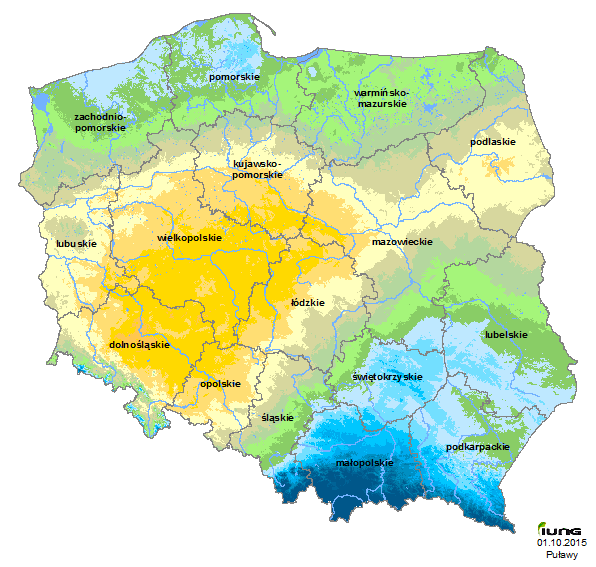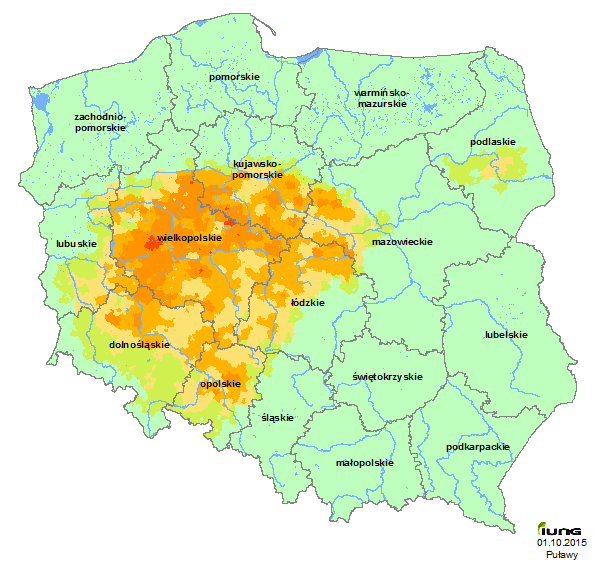ARCHIVES (2015)
Do roku 2016 raport oznaczony numerem 1 był tworzony za okres od 1 kwietnia do 31 maja. Od roku 2017 analizy są wykonywane o dekadę wcześniej czyli 1 raport oznacza okres od 21 marca do 20 maja
Communication report regarding the incidences of drought conditions in Poland
Year: 2015; period: 13 (1.VIII - 30.IX)
The Institute of Soil Science and Plant Cultivation - State Research Institute in accordance with an Act from the Minister of Agriculture and Rural Development has developed the climatic water balance for all Polish municipalities (3,064 municipalities), and based on the soils categories have identified in those municipalities the current agricultural drought risk for the following crops: rape, turnip rape and sugar beet.
In the twelfth reporting period, i.e. from August 1 to September 30, 2015, does state a risk of agricultural drought in Poland. The values of climatic water balance (CWB), which are the basis to assess the risk of drought, are negative.
In the current sixty days period threat to agricultural drought occurs among crops:
- Rape and turnip rape
- Sugar beet
The value of CWB on Polish territory compared to the previous reporting period had increased by 16 mm on average for the country. In south and south-east parts of Poland, was recorded the highest increase of CWB between 20 and 100 mm. While in the northern and north-western regions of the country compared to the previous period, it reported a decrease in the CWB ranging from 20 to 50 mm.
In the current reporting period (01.08.-30.09.2015) the highest risk of drought have been reported in the Dolnośląskie, Wielkopolskie, Opolskie, Łódzkie, Kujawsko-pomorskie and Mazowieckie voivodeships. At this territory the shortage of water ranges from 170 to 199 mm. The severe shortage of water for agriculture is quoted also in Lubuskie, Podlaskie and in the western part of the Śląskie, it ranges from 150 to 170 mm.
At present threat of drought in Poland there for rape and turnip rape grown on soils category II and sugar beet grown on soils II and III category of drought vulnerability.
Drought for rape and turnip rape occurs in 9 voivodeships of the country, in 899 local districts (29.3 % of local districts) on 9.7% of arable land.
The highest risk of drought (in over 90% of local districts) have been reported in the Wielkopolskie voivodeship. Very high risk of drought also occurs in Dolnośląskie and Łudzkie voivodeships (over 90 % of local districts) as well as in Kujawsko-Pomorskie (58.1% of local district).
To regions with a high risk of drought among these crops may include the Lubuskie voivodeships (over 48% of local districts).
Detailed data on this crop are presented in Table 1.
Table 1. Risk of agricultural drought for rape and turnip rape crops
| No. | Voivodeship | Number of local districts | Number of local districts at risk | The share of local districts under risk [%] | The share of arable land under risk[%] |
|---|---|---|---|---|---|
| 1 | wielkopolskie | 316 | 288 | 91.1 | 41.5 |
| 2 | opolskie | 103 | 83 | 80.6 | 16.5 |
| 3 | dolnośląskie | 224 | 156 | 69.6 | 14.8 |
| 4 | łódzkie | 202 | 123 | 60.9 | 17.9 |
| 5 | kujawsko-pomorskie | 179 | 104 | 58.1 | 22.3 |
| 6 | lubuskie | 116 | 56 | 48.3 | 8.0 |
| 7 | podlaskie | 141 | 26 | 18.4 | 0.8 |
| 8 | mazowieckie | 364 | 58 | 15.9 | 5.2 |
| 9 | śląskie | 189 | 5 | 2.6 | 0.1 |
| Polska | 3064 | 899 | 29.3 | 9.7 |
Drought for sugar beet occurs in 9 voivodeships of the country, in 899 local districts (29.3 % of local districts) on 9.7% of arable land.
The highest risk of drought (in over 90% of local districts) have been reported in the Wielkopolskie voivodeship. Very high risk of drought also occurs in Opolskie voivodeship (more than 80% of local district). High risk of drought is also found in Dolnośląskie, Lodzkie (more than 60% of local districts) and in Kujawsko-Pomorskie (in 58.1% of local district).
To regions with a high risk of drought among this crop may include Lubuskie where over 48% of local districts).
Detailed data on this crop are presented in Table 2.
Table 2. The threat of agricultural drought for potato cultivation.
| No. | Voivodeship | Number of local districts | Number of local districts at risk | The share of local districts under risk [%] | The share of arable land under risk [%] |
|---|---|---|---|---|---|
| 1 | wielkopolskie | 316 | 288 | 91.1 | 41.5 |
| 2 | opolskie | 103 | 83 | 80.6 | 16.5 |
| 3 | dolnośląskie | 224 | 156 | 69.6 | 16.3 |
| 4 | łódzkie | 202 | 123 | 60.9 | 17.9 |
| 5 | kujawsko-pomorskie | 179 | 104 | 58.1 | 22.3 |
| 6 | lubuskie | 116 | 56 | 48.3 | 8.0 |
| 7 | podlaskie | 141 | 26 | 18.4 | 0.8 |
| 8 | mazowieckie | 364 | 58 | 15.9 | 5.2 |
| 9 | śląskie | 189 | 5 | 2.6 | 0.1 |
| Polska | 3064 | 899 | 29.3 | 9.7 |
In August the coldest was on the Embankment with temperature below 20°C. In the southern regions of Pomorskie Lake District, the area of the Mazurskie Lake District were recorded from 20 to 21 ° C. Warmest, more than 23 ° C, it was the Śląskie Lowland. In the rest of the country was recorded from 21 to 23 ° C. This year's August was very warm. In the north air temperature was higher than the long-term average by 2 to 4 ° C. In the rest of country recorded temperature higher than the long-term by 4 to 5 ° C and sometimes even higher by more than 5 ° C.
In the first ten days of September it recorded a relatively high temperature reduction to below 14 ° C, at the Pomorskie Lake District and Podlasie. In the rest of Poland also it was cool from 14 to 16 ° C, only the Opole region of Dolny Śląsk recorded temperatures exceeding 16 ° C. The second ten days of this month was warmer. In the north of the country recorded a temperature of 15.5 to 16.5 ° C, the farther south of the country that was warmer, in centre of country from 16.5 to 17.5 ° C in the Sandomierz Basin and especially in Podkarpacie reported from 18 to more than 18.5 ° C. The third ten days of this month was the coldest air temperature in most parts of country ranging from 11 to 12 °C, only the south-west and east was a bit warm 12-13 °C.
This year in August was extremely dry. The lowest rainfall of less than 10 mm were recorded in Kujawy, Żuławy, Izerskie Foothills, Dolnośląskie Bory, Mazowiecka Lowland, the Lublin Upland and Polesie. A substantial area of the country also was recorded with low rainfall of 10 to 30 mm, only in the area of Kalisz Upland, Leszno Upland Krakow-Czestochowa Upland and in the western part of the Małopolska Highland recorded rainfall greater than 30 to more than 60 mm. In Kujawy, eastern areas Lublin region, southern regions of Śląskie and Mazowsze Lowland rainfall amounted to 10% of normal long-term norm. On the majority of the country rainfall ranged from 10 to 30% of normal long-term norm. Only in the area of Kalisz Upland, Leszno and Krakow-Czestochowa Upland rainfall was slightly higher, from 70 to 100% of norm.
The first ten days of September was characterised with a very diverse precipitation. High rainfall occurred in Kaszuby and in the western part of the Pomorskie Lake District from 50 to 90 mm and sometimes even more than 90 mm. The lowest rainfall recorded in Wielkopolska, in the southern part of the Śląska Lowland, Podlasie, Małopolska Highland, Sandomierz Basin and the Karpackie Foothills from 10 to 20 mm.
In the second ten days of September also marked by a very diverse precipitation. The high rainfall, as in the first ten days of this month, occurred in the western part of the Pomorskie Lake District, more precipitation was recorded also in the north-eastern part of the country and a large territory south-eastern Poland, from 20 to more than 50 mm. The lowest rainfall less than 10 mm were recorded in Wielkopolska, and in the southern part of the Śląska Lowland and Podlasie.
As in the first two periods of September also in the third ten days period marked by a very large diverse in the country in terms of volume of precipitation. The highest rainfall from 40 to over 50 mm was recorded in the south-eastern area of the country. Relatively large rainfall was also recorded in the eastern regions ranging from 10 to 40 mm. In the rest of country precipitation amounted of less than 5 mm.
The current water resources were adequate enough for risen rape seeds despite the large soil drought. However, there are significant defects observed in the emergence and it must be said that they are very uneven. A further period of little rain could worsen the situation, so that before winter plants will evolve not good rosettes of 8-10 leaves and the root crown does not reach a diameter of 10 mm, which will increase further losses in yields of these crops. Occurring weather conditions have made, especially in the eastern and south -eastern parts of the country improving soil moisture conditions, but unfortunately the improvement of these conditions is not too big for the cultivation of sugar beet. Adverse conditions in the vegetation in previous periods are so high that the current weather situation is no longer able to cause a significant increase in the yield of these crops.
Reports
- Report 13 (1.VIII - 30.IX) +
- Report 12 (21.VII - 20.IX) +
- Report 11 (11.VII - 10.IX) +
- Report 10 (1.VII - 31.VIII) +
- Report 09 (21.VI - 20.VIII) +
- Report 08 (11.VI - 10.VIII) +
- Report 07 (1.VI - 31.VII)
- Report 06 (21.V - 20.VII)
- Report 05 (11.V - 10.VII) +
- Report 04 (1.V - 30.VI) +
- Report 03 (21.IV - 20.VI) +
- Report 02 (11.IV - 10.VI) +
- Report 01 (1.IV - 31.V)





